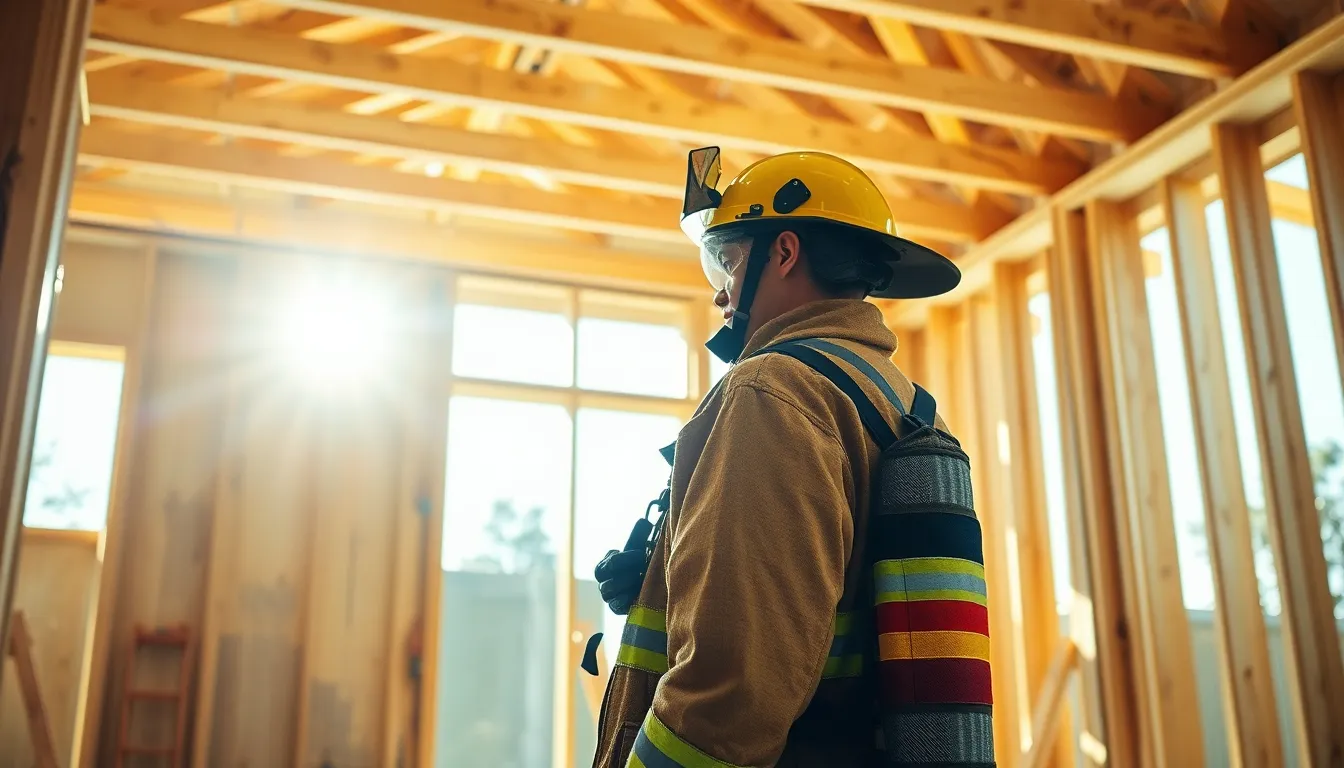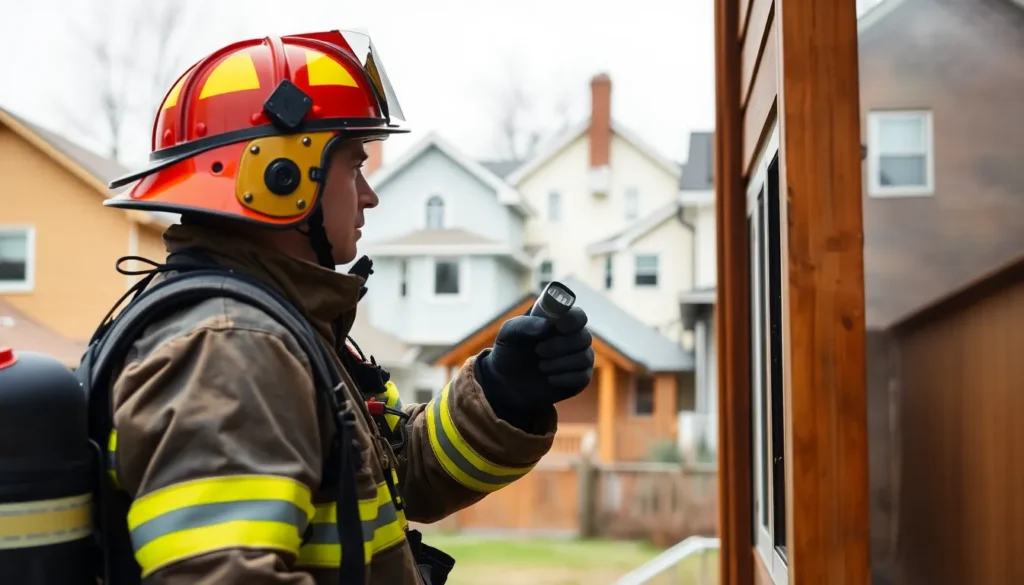Table of Contents
ToggleWhen it comes to battling blazes, firefighters need more than just a hose and a helmet. They need to understand the very structures they’re racing into. Building construction for the fire service isn’t just a technical topic; it’s a life-saving necessity. Imagine charging into a building that’s more of a house of cards than a fortress. It’s like playing a game of Jenga, but with flames and a ticking clock.
Understanding construction types, materials, and design can mean the difference between a heroic rescue and a hasty retreat. From the cozy charm of a wooden cottage to the steel skeleton of a high-rise, each structure presents unique challenges and opportunities. So let’s dive into the nitty-gritty of building construction and arm our brave firefighters with the knowledge they need to conquer any inferno. After all, knowing the enemy—especially when it’s made of drywall and timbers—can turn a potential disaster into a triumphant save.
Understanding Building Construction
Understanding building construction is vital for firefighters. It equips them with knowledge that directly impacts safety during operations.
Types of Building Construction
Firefighters encounter various construction types, including wood-frame, masonry, and steel structures. Wood-frame buildings, often found in residential areas, present unique challenges due to their rapid combustion. Masonry structures, like brick buildings, provide more fire resistance but may collapse under heat. Steel buildings, commonly used in commercial settings, can lose structural integrity when exposed to high temperatures. Each construction type requires specific tactics during firefighting efforts to mitigate risks effectively.
Importance of Building Materials
Building materials significantly influence fire behavior and risk levels. Combustible materials increase the fire load, complicating extinguishment efforts. Non-combustible materials, such as concrete and metal, slow fire spread and enhance stability during firefighting. Insulation materials also play a role; some can emit toxic gases when burned. Understanding the materials in a building informs firefighters about potential hazards, enabling safer and more efficient response strategies.
Fire Behavior in Buildings

Understanding fire behavior in buildings is crucial for effective firefighting. Several factors influence how fire spreads within a structure.
Factors Affecting Fire Spread
Construction materials play a significant role in fire spread. Combustible materials, like wood and textiles, contribute to rapid flame propagation. Additionally, building layout impacts airflow, enhancing fire behavior. Open floor plans facilitate quicker fire movement, while compartmentalized layouts can slow it down. Ventilation also affects intensity; increased air supply intensifies flames. Weather conditions further influence fire dynamics, especially strong winds that can spread flames quickly. Fire suppression systems’ effectiveness impacts containment efficiency, highlighting the importance of maintaining functional equipment.
Fire Resistance Ratings
Fire resistance ratings indicate a building’s ability to withstand fire exposure. Materials are tested and assigned ratings based on durability during high heat. Common ratings include 1-hour, 2-hour, and 3-hour classifications, reflecting how long materials can endure flames. Non-combustible materials like concrete receive higher ratings, offering better protection. Conversely, wood-frame structures typically receive lower ratings, indicating greater vulnerability. Understanding these ratings aids firefighters in assessing risks quickly. Building codes often require certain ratings for specific structures, ensuring compliance and safety during emergencies.
Construction Features Relevant to Fire Service
Understanding construction features is vital for effective firefighting operations. Structural components and fire protection systems play significant roles in managing fire risks.
Structural Elements
Structural elements directly influence how fire behaves within a building. Load-bearing walls support the overall framework, while beams and columns provide stability. Firefighters rely on this knowledge to assess potential collapse risks. Roof types, including flat and pitched designs, determine how fire can spread or be contained. Additionally, materials such as wood and steel each react differently under heat exposure, affecting firefighting tactics. Recognizing these elements allows firefighters to strategize their approach when entering structures.
Fire Protection Systems
Fire protection systems are essential for safeguarding occupants and property. Fire alarms and sprinkler systems significantly mitigate risks during a fire event. When functioning properly, they activate to alert occupants and suppress flames. Furthermore, standpipe systems provide firefighters with immediate access to water, enhancing extinguishment efforts. Knowledge of these systems helps firefighters navigate buildings more effectively. Building codes often dictate the required fire protection measures, ensuring compliance and safety for all. Familiarity with these features equips firefighters with crucial tools for emergency incidents.
Challenges for Firefighters
Firefighters face multiple challenges when it comes to building construction. Understanding these obstacles is crucial for effective response during emergencies.
Access and Egress Considerations
Access routes often prove critical for firefighters. Narrow streets can hinder larger fire apparatus, limiting response times. Stairs and elevators may pose additional challenges, especially in high-rise structures. Without proper egress routes, occupants may find themselves trapped. Firefighters must assess these pathways quickly to determine how to enter or evacuate efficiently. Additionally, obstructions such as vehicles or construction equipment can further complicate access. Understanding these factors helps firefighters plan their approach and ensures minimal delay during operations.
Understanding Building Layouts
Building layouts significantly affect fire behavior and firefighter tactics. Open floor plans allow rapid fire spread, while compartmentalized designs can contain flames, presenting mixed challenges. Knowledge of high ceilings in warehouses may indicate potential for smoke accumulation. Structural features such as load-bearing walls impact both stability and firefighting tactics. Awareness of potential location for hazardous materials in certain areas also plays a key role in assessing risks. Familiarity with these layouts enables firefighters to create effective strategies for rescue and suppression efforts.
Best Practices for Fire Service Response
Understanding the construction types and features enhances firefighting effectiveness. It guides decision-making in emergencies, ensuring safety and efficiency.
Pre-Incident Planning
Pre-incident planning forms a crucial part of effective fire service response. Firefighters benefit from familiarizing themselves with local buildings and their unique characteristics. Identifying potential risks through building inspections reveals vulnerabilities such as inadequate exits or combustible materials. Equally, accessing blueprints provides insight into layout, aiding strategic firefighting approaches. Engaging with building owners fosters collaboration, making it easier to obtain critical information and address safety concerns proactively. Regular updates to plans ensure they remain relevant as modifications occur in structures.
Training and Education
Training and education equip firefighters with necessary skills for diverse construction scenarios. Live drills afford them hands-on experience with different building materials and designs. Courses on fire behavior and structural integrity deepen their understanding of how fires impact various constructions. Incorporating scenario-based training hones decision-making under pressure, preparing firefighters for real incidents. Additionally, keeping up with current building codes and technologies allows crews to adapt to evolving risks. Continuous education promotes safety, enhances firefighting techniques, and ultimately saves lives.
Understanding building construction is vital for firefighters to navigate emergencies effectively. This knowledge not only enhances safety but also improves decision-making during critical situations. By recognizing the unique challenges presented by various construction types and materials, firefighters can strategize their responses to minimize risks.
The significance of pre-incident planning and continuous training cannot be overstated. Familiarity with local structures and ongoing education equips firefighters with the tools they need to tackle diverse scenarios. As they hone their skills and deepen their understanding of fire behavior, they become better prepared to protect lives and property. Ultimately, this expertise is essential for ensuring successful firefighting operations in an ever-evolving landscape of building construction.







